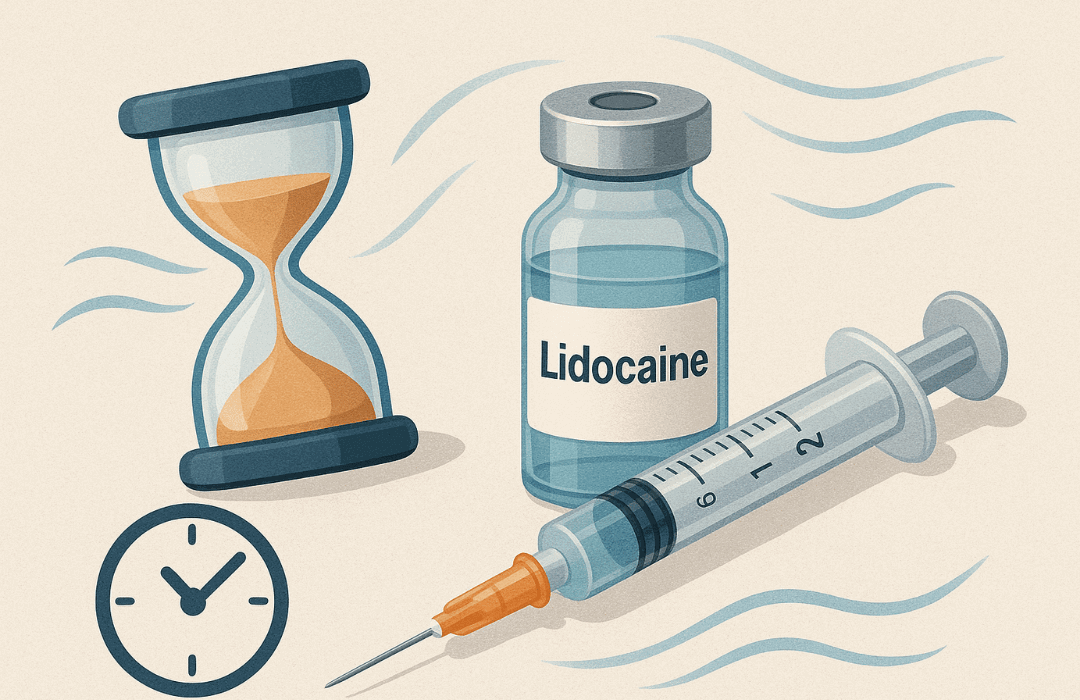Still Numb After the Dentist? Here’s How Long Dental Numbing Lasts
You know the drill: you get a cavity filled, walk out of the dentist’s office, and suddenly your lip feels three times bigger than it really is. Talking is awkward, eating is impossible, and all you can think is… how long does dental numbing last?
For most people, the numbness from lidocaine or other dental anesthetics wears off in a couple of hours. But the truth is, it’s not the same for everyone. The type of procedure, the dose, and even your own metabolism can change how long that “frozen face” sticks around.
In this post, we’ll cover how long dental numbing usually lasts, why it can vary so much, and what you can (safely) do if you’re ready to feel normal again.
What Is Lidocaine and How Does It Work?
Before answering how long does dental numbing last, it helps to know what’s actually happening inside your mouth.
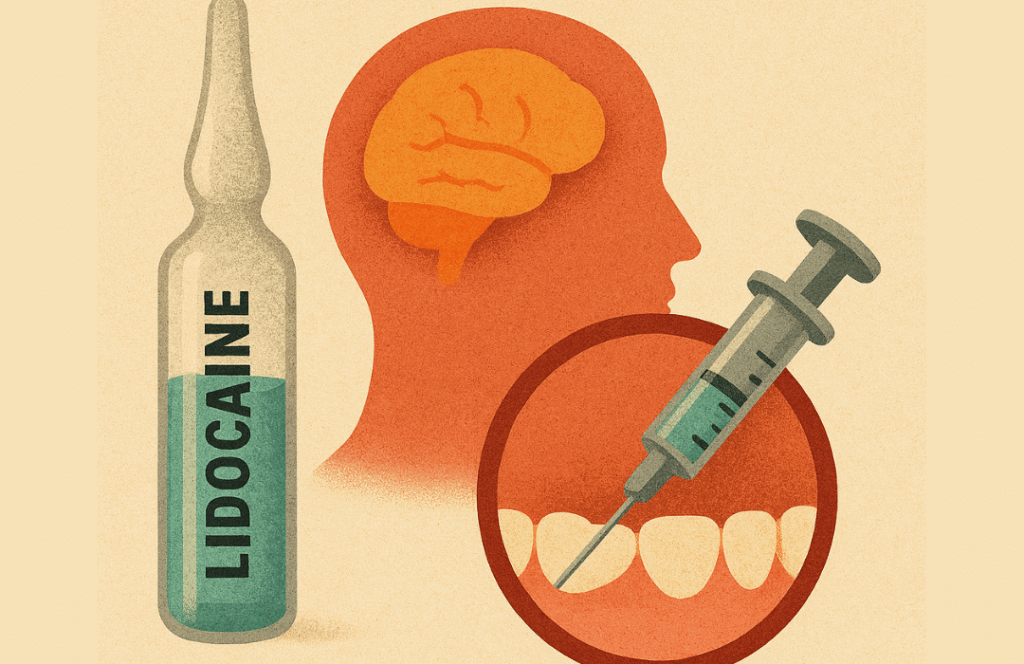
Dentists often rely on a local anesthetic called lidocaine it’s been used safely for decades in dental offices across the U.S. Unlike general anesthesia, lidocaine doesn’t put you to sleep. Instead, it targets the nerves in one specific area of your mouth and blocks them from sending pain signals to your brain. That’s why you can sit through a filling, root canal, or even a tooth extraction without feeling sharp pain.
Here’s how it works in simple terms: when your dentist injects lidocaine near a tooth or gum tissue, the medication surrounds the nerve endings. Think of it as putting a temporary “pause button” on those nerves. You’ll still feel pressure, movement, or vibration, but not the sting of pain.
The effect isn’t permanent, of course. Your bloodstream gradually carries the medication away, and your liver metabolizes it. This is why lidocaine usually lasts about one to three hours, though the exact timing depends on the type of dental procedure, where the injection was placed, and your body’s unique chemistry.
Fun fact: lidocaine is one of the most common anesthetics worldwide, but dentists sometimes choose alternatives like articaine or mepivacaine for specific procedures. Each has slightly different strengths, which is why numbness doesn’t always last the same amount of time for everyone.
How Long Does Lidocaine Last?
One of the first questions people ask after a dental visit is: “How long does dental numbing last?” The short answer is usually one to three hours, but the truth is a little more nuanced. The duration of numbness depends on what kind of dental work you had, the dose, and even the specific formula of anesthetic your dentist used.
Fillings and Simple Procedures
For a small filling or a minor repair, you’ll probably notice the numbness fading within 1–2 hours. The dose tends to be smaller, and your body clears it faster. Many patients even regain sensation before they leave work or school that same afternoon.
Tooth Extractions and More Invasive Work
Bigger jobs like wisdom tooth removal, root canals, or gum surgery require stronger or longer-acting anesthesia. In those cases, the numbness can stretch to 3–5 hours. Some people even feel tingling into the evening if the procedure was late in the day.
The Role of Epinephrine
Often, lidocaine is combined with a medication called epinephrine. This isn’t to wake you up, it’s to make the anesthetic last longer. Epinephrine narrows blood vessels near the injection site, slowing down how quickly your body absorbs the lidocaine. The result? The numbness hangs around toward the higher end of the range, closer to 4–5 hours.
Topical Numbing (Gel or Spray)
Not all numbing comes from an injection. Dentists sometimes apply a numbing gel or spray before giving the shot, or for very minor treatments like cleaning around sensitive gums. That type of numbing is much shorter typically 15–30 minutes and wears off before you even leave the office.
The Bottom Line
So, how long does lidocaine last in dentistry? Most people feel back to normal in a couple of hours, but if you’ve had a bigger procedure or anesthetic with epinephrine, don’t be surprised if the “frozen” feeling lingers for part of the day. Everyone’s body processes medication a little differently, so your experience might not match your friend’s and that’s perfectly normal.
Factors That Affect Numbing Duration
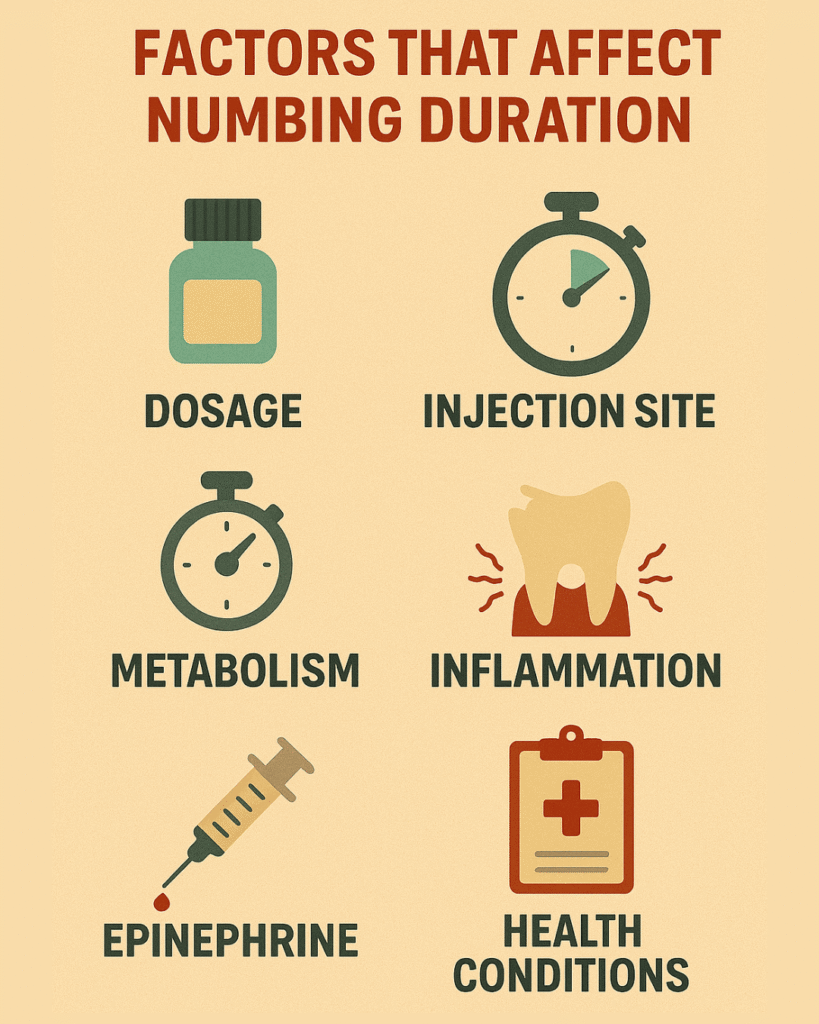
Not everyone experiences dental numbness the same way. While most patients start to feel normal again after a couple of hours, there are several factors that can make the effects of lidocaine wear off faster, or linger much longer. Understanding these can help you know what to expect after your dental visit.
1. Dosage and Concentration
A quick filling or minor dental touch-up usually requires a lower dose of anesthetic, which tends to wear off faster sometimes within an hour or two. On the other hand, more complex procedures like root canals or multiple extractions often involve higher doses or stronger concentrations. That extra medication means your mouth may stay numb well into the afternoon.
2. Location of the Injection
Where the anesthetic is given matters. The lower jaw, for example, has denser bone and higher blood flow, which can change how quickly your body processes lidocaine. In contrast, injections in the upper jaw are often absorbed more slowly, meaning the numbness can last a little longer.
3. Your Metabolism and Body Chemistry
Everyone’s body breaks down lidocaine differently. If you’re young, active, and healthy, your metabolism may clear the medication quickly. But if you have liver conditions, circulatory issues, or simply a slower metabolism, you might notice the numbing effect hanging around longer than average.
4. Use of Epinephrine
Many dentists add a small amount of epinephrine (adrenaline) to lidocaine. This causes the blood vessels in the area to constrict, which slows down absorption into the bloodstream. The result? A stronger, longer-lasting numbness sometimes stretching to 4 or even 5 hours.
5. Inflammation or Infection
If you’re being treated for an infected tooth or swollen gums, your body may respond differently to the anesthetic. Inflammation can either shorten the duration (because the area has higher blood flow) or make the anesthetic less effective. That’s why patients with tooth abscesses sometimes feel the numbness wearing off sooner than expected.
6. Other Medications or Health Conditions
Certain prescription drugs, like beta-blockers or medications that affect the liver, can alter how long dental numbing lasts. Chronic health conditions such as diabetes, high blood pressure, or heart disease may also influence circulation and how your body handles lidocaine.
How long does dental numbing last? It’s not the same for everyone. Your dose, where the anesthetic was placed, your metabolism, and even your overall health all play a role in how long you’ll feel that familiar “frozen” sensation.
How to Make Lidocaine Wear Off Faster
If you’ve ever left the dentist’s office with half your face still feeling like rubber, you know how frustrating lingering numbness can be. While there’s no magic button to turn it off instantly, there are a few safe, practical ways to help your body process lidocaine more efficiently so you can get back to feeling normal sooner.
Get Moving (But Keep It Gentle)
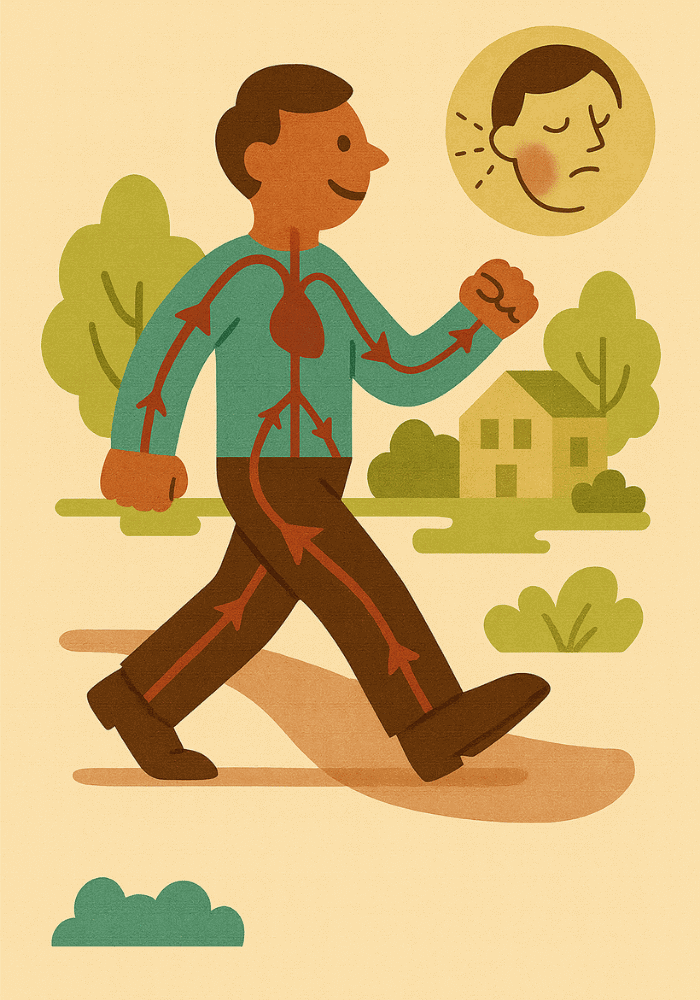
Light physical activity like walking around your neighborhood, stretching, or doing simple household tasks can boost blood circulation. The better your blood is flowing, the faster your body can metabolize the anesthetic and flush it out of your system. Think of it as helping your body “wake up” from the numbing.
Massage the Area, If It’s Safe
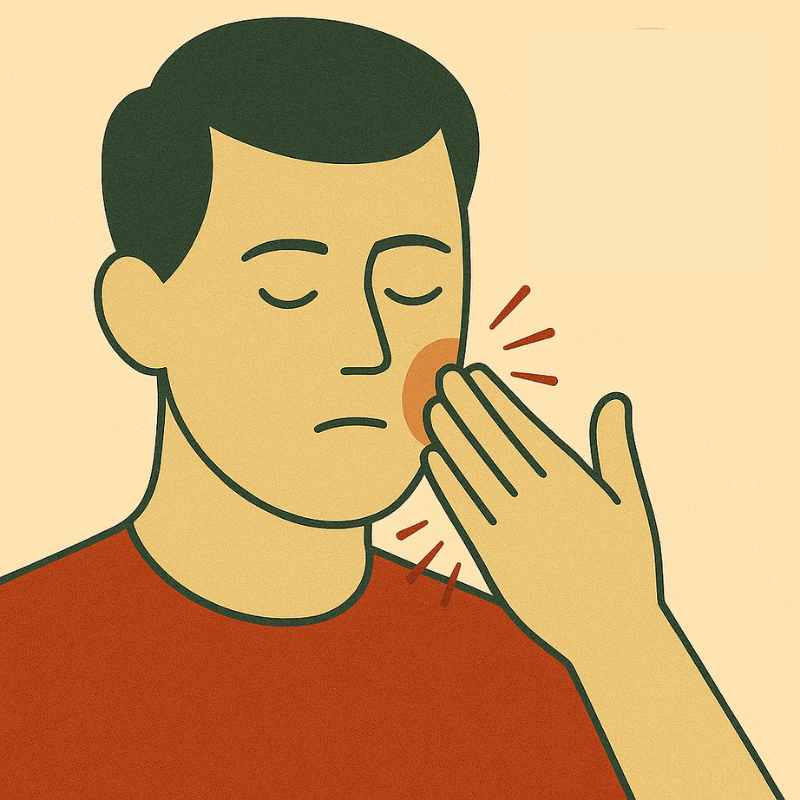
If your dentist gives you the okay, gently massaging the cheek or lip near the injection site can increase circulation and help the numbness fade more quickly. But a word of caution: skip this if you just had oral surgery, stitches, or an extraction, since touching the area could interfere with healing or cause irritation.
Stay Hydrated

Water plays a huge role in how quickly your body processes medications. Staying well-hydrated supports your metabolism and encourages your system to flush out lidocaine naturally. Think of each glass of water as a step closer to regaining full sensation.
Warm Compress (When Appropriate)
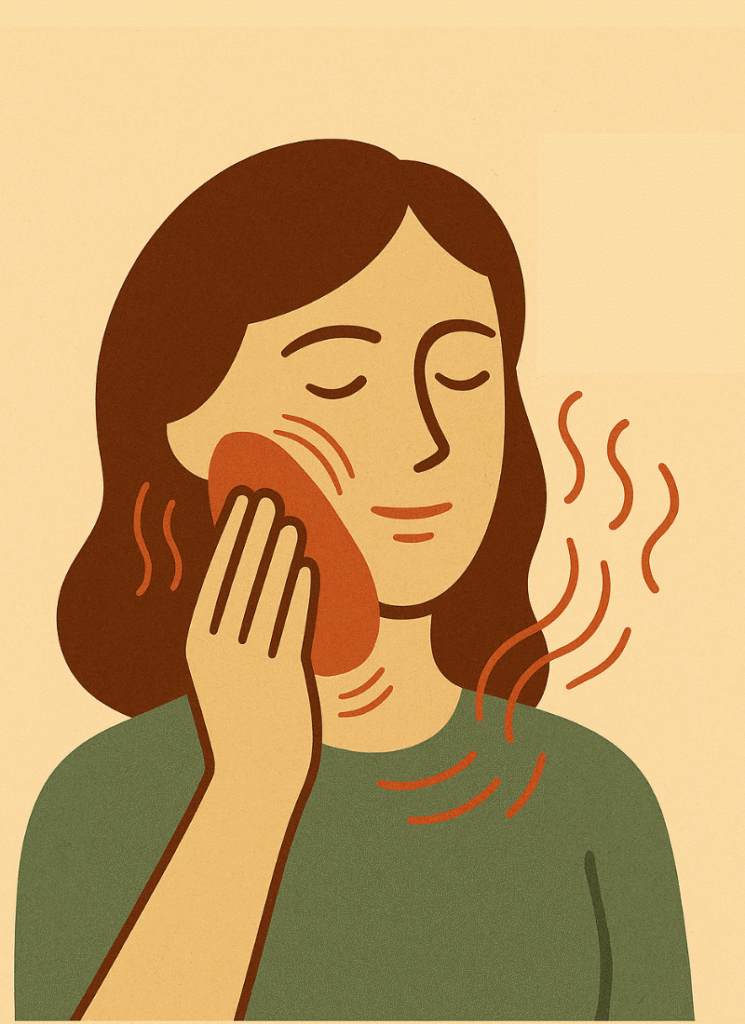
A warm (never hot) compress applied to the outside of your cheek may help improve blood flow in the area. This simple step can sometimes make the numbing wear off sooner. However, if your dentist specifically advised using ice or keeping the area cool like after a tooth extraction stick with their instructions instead.
Be Patient, Time Does the Heavy Lifting
Here’s the truth: most dental numbing lasts only 1–3 hours, and your body is already working to clear it. Trying risky “home remedies” or unproven hacks isn’t worth it. The safest path is to let time do its job while using the gentle methods above to support the process.
Ask About Reversal Options: Some dental offices offer a medication called phentolamine mesylate, which can reverse local anesthesia and cut the numbing time almost in half. It’s not available everywhere, but if you know you’re especially uncomfortable with prolonged numbness, it’s worth asking your dentist whether they provide this option.
When to See a Doctor
For most patients, dental numbing is nothing more than a temporary inconvenience. You leave the office, deal with a few hours of tingling lips or a “frozen” smile, and by the time you’re back to your normal routine, the anesthesia has already worn off. But every so often, your body may send signals that something isn’t quite right. Knowing when to pick up the phone and call your dentist is important not just for your peace of mind, but also for your health.
Call Your Dentist If:
- Numbness lasts longer than 6–8 hours. By this point, you should usually feel sensation returning. If your mouth is still completely numb, it’s a good idea to get checked.
- You feel unusual sensations. Burning, tingling, or a strange “pins and needles” feeling that worsens instead of improving could be a sign that a nerve was irritated during the injection.
- The injection site looks or feels off. Extra swelling, tenderness, or a patch of skin that feels different from the rest of your mouth is worth mentioning to your dentist.
Seek Emergency Care If:
- You have sudden swelling that affects breathing or swallowing. This could signal a rare but serious allergic reaction.
- You break out in hives or a rash. These are also warning signs of an allergic response to lidocaine or another component of the injection.
- You notice difficulty speaking, facial weakness, or anything that feels alarmingly unusual. While rare, these symptoms should never be ignored.
Real-Life Story
A few months ago, a 15-year-old girl shared her experience online after a simple dental visit turned unexpectedly stressful.
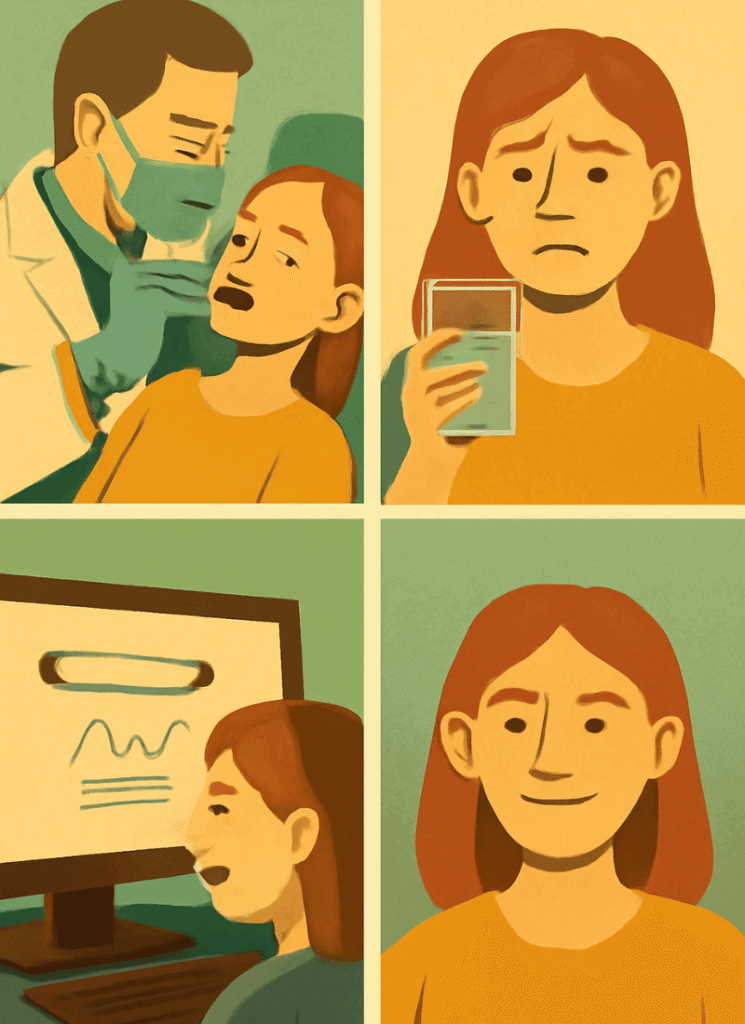
She had gone in for a small surface filling on one of her upper molars a routine procedure that takes less than 30 minutes. Her dentist used a local anesthetic (most likely lidocaine) to numb the area before drilling. Everything went smoothly, and she went home thinking the feeling would return to normal within an hour or two.
But by mid-afternoon, something felt off. While most of the numbness had faded, part of her upper lip still felt strange. When she tried to pucker her lips, one side wouldn’t move quite right and every time she took a sip of water, a little bit would dribble out. Naturally, she started to panic. A quick Google search only made things worse, leading her to think she might have nerve damage.
The truth? Her situation was completely normal. In some people especially younger patients or those with a slower metabolism dental numbing can linger for 4 to 6 hours, sometimes even a bit longer. The nerves around the upper lip are delicate, and mild temporary weakness or uneven sensation can happen as the anesthetic wears off.
By the evening, her smile had returned to normal, and the lingering numbness was gone. No nerve damage, no complications, just a little extra time for her body to process the lidocaine.
The Takeaway : If you ever feel like your dental numbing is lasting longer than usual, don’t panic. Everyone’s body reacts differently, and mild unevenness or drooling is almost always temporary. But if numbness continues for more than 6–8 hours or you notice persistent tingling, it’s best to check in with your dentist just like she did.
FAQs About Lidocaine Numbing
| 💬 How long does dental numbing last after a filling? |
| ✅ Usually between 2 and 4 hours. If it’s a small cavity, it may fade faster. Bigger procedures like root canals or extractions can last longer. |
| 💬 Why is my mouth still numb after 5 hours? |
| ✅ For some people especially with injections in the lower jaw numbing can linger. If it lasts more than 6–8 hours or feels worse over time, call your dentist just to be safe. |
| 💬 Can lidocaine cause permanent nerve damage? |
| ✅ It’s extremely rare. Most numbness is temporary. In unusual cases, the needle may irritate a nerve, but even then sensation often returns within weeks or months. |
| 💬 Is there a way to make lidocaine wear off faster? |
| ✅ Movement helps: gentle jaw activity, walking around, or sipping water can boost blood flow. Some dentists also offer a reversal medication called OraVerse. Always check with your dentist before trying anything unusual. We talked about this in more detail earlier, scroll up to the section “How to Make Lidocaine Wear Off Faster” for a full breakdown of what you can do. |
| 💬 What’s the best way to eat while still numb? |
| ✅ Stick to soft, cool foods (yogurt, smoothies, applesauce). Avoid hot drinks and chewing on the numb side. You don’t want to bite your cheek without realizing it. |
Conclusion
Dental numbing might feel strange, but it’s your body’s way of making sure you get through dental work without pain. For most people, the tingling fades within a few hours and life goes back to normal. If it seems to be lasting a little longer than expected, don’t panic everyone’s body processes anesthesia differently.
The key takeaway: temporary numbness is normal, permanent problems are rare. Simple steps like staying patient, protecting your mouth while it’s numb, and calling your dentist if you’re unsure can make the whole experience much easier.
So the next time you wonder, “How long does dental numbing last?” remember: a few hours of tingling is a small price to pay for a pain-free smile. And if you ever feel something isn’t right, your dentist is just one phone call away.

